The iPhone 6 Review
by Joshua Ho, Brandon Chester, Chris Heinonen & Ryan Smith on September 30, 2014 8:01 AM EST- Posted in
- Smartphones
- Apple
- Mobile
- iPhone 6
GPU Performance
While we don't quite have real games to benchmark against, we do have benchmarks that are reasonably good approximations of games, which heavily stress the GPU. For the most part, this means that we can see the performance of the A8's PowerVR GX6450 GPU but there are some aspects that are CPU-bound, which we'll discuss after the results.
Edit: Before I get into the results, I must caution that Basemark X will have inaccurate on-screen results as the benchmark was made using XCode 5.x in order to keep scores comparable between versions 1.1 and 1.1.1. This doesn't affect the overall score, which is solely calculated based upon off-screen performance.
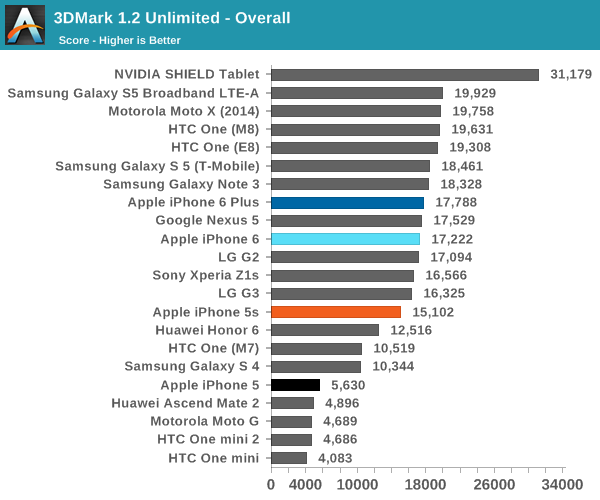
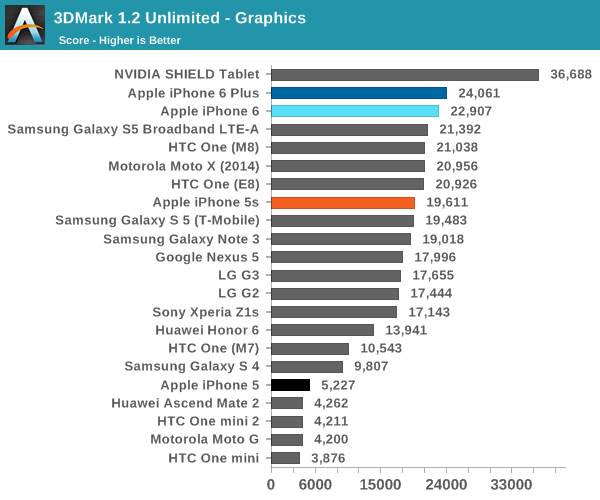
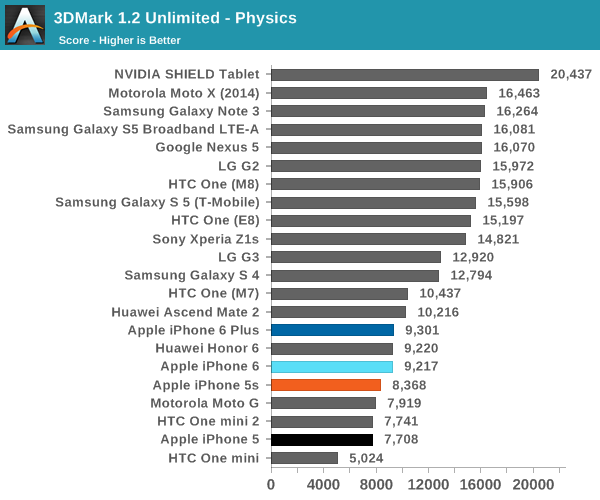
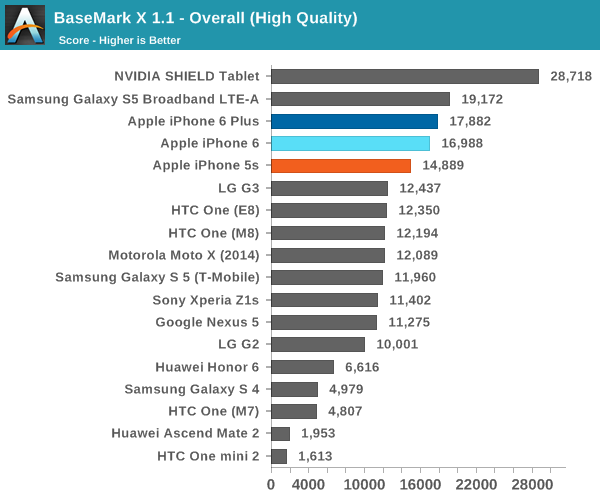

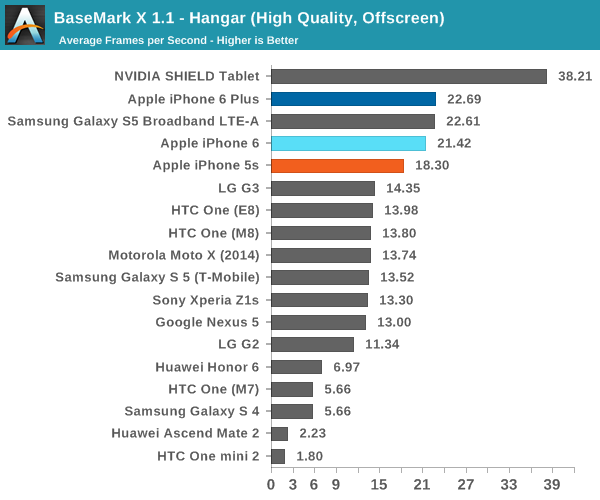

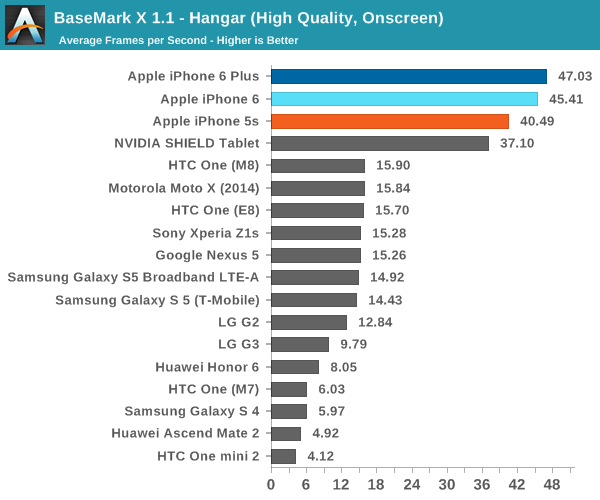
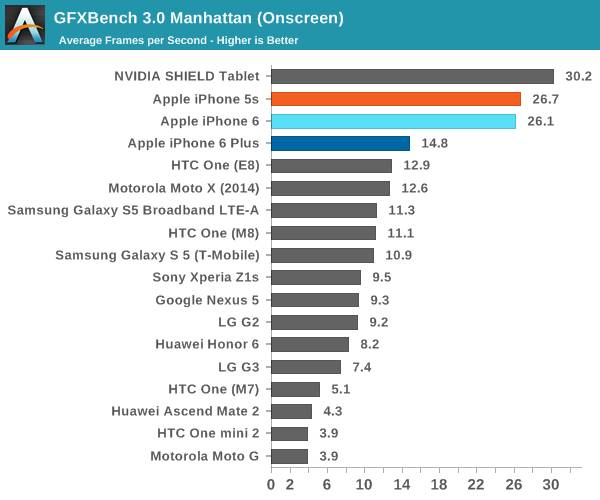


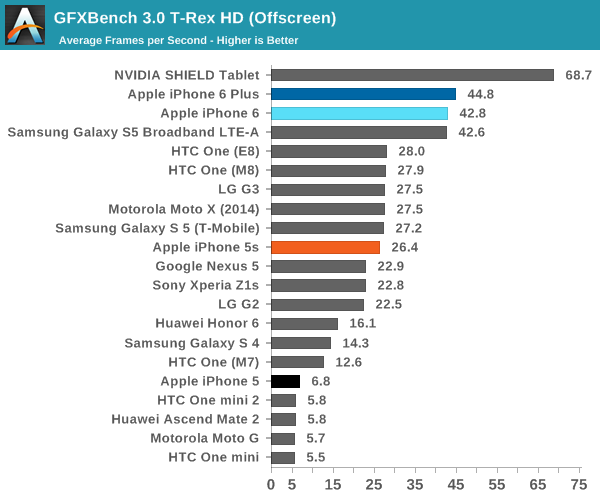
For the most part, we see that the GX6450 is at about the same level as Qualcomm's Adreno 420, which seems to track closely to expectations given that the A7's GPU was around the same performance as the Adreno 330. The 3DMark test does have an interesting result, but it seems that this is because 3DMark's physics test has a strong amount of data dependency that restricts the level of out of order execution that can be done. NVIDIA's Tegra K1 is the current leader in graphics performance, but of course it's also in a tablet instead of a smartphone so it's not a direct competitor.
NAND Performance
As we move towards the goal of seamless performance in everyday tasks, one significant factor is IO performance. While there's definitely a minimum level of performance that allows for generally acceptable smoothness, there's value in having higher storage performance (e.g. prevent bottlenecking in situations such as updating apps in the background). In order to test this, we use Androbench with some custom settings on Android and a custom utility developed by Eric Patno for iOS, who has been quite helpful with furthering our efforts to test storage performance.
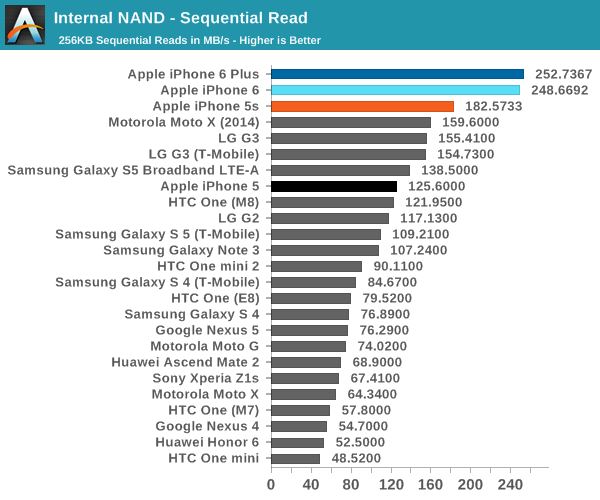
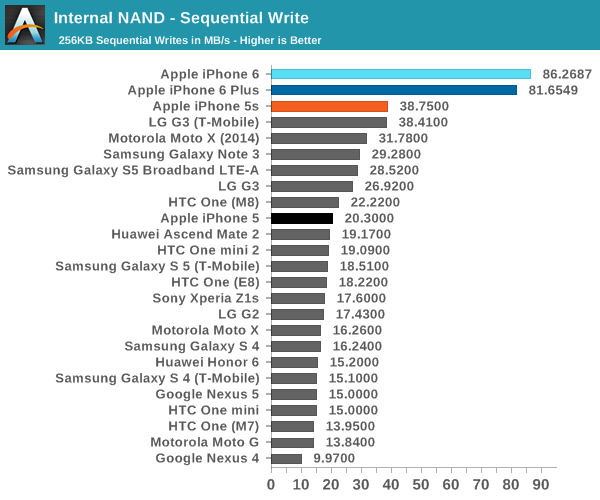
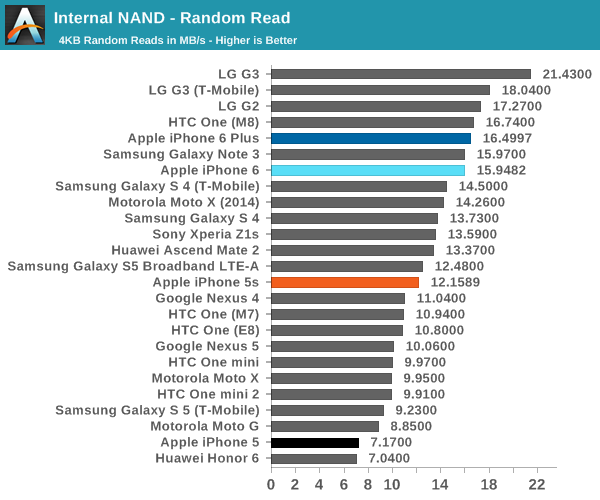
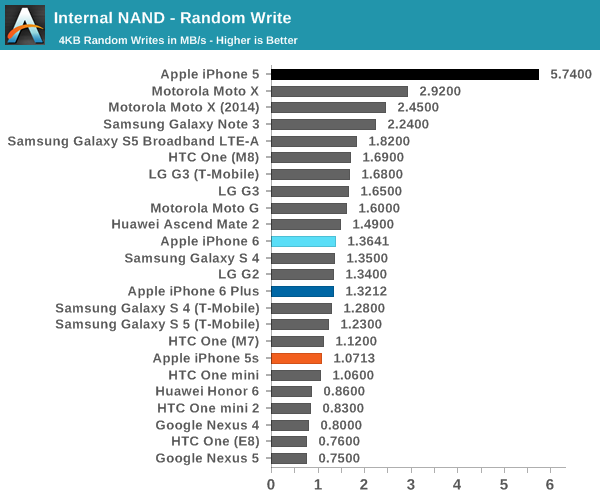
As this is the first time that we've looked into NAND performance on iOS devices, it's definitely worth scrutinizing the data a bit more closely than in most cases. There are a few notable cases here, which are the class-leading speeds for sequential reads and writes on the iPhone 6, but also the rather middling random read and write speeds for the iPhone 6 and 5s. The oddest result is definitely the iPhone 5, which is Ryan's personal unit and while the random read speeds are on the low side, random write speeds are easily record-setting.
In practice, with tablets and smartphones being less multitasking heavy than PCs/laptops, the sequential scores are probably slightly more relevant to the overall user experience. The iPhone 6 results show a significant increase in performance over the iPhone 5s in all of the tests, which is always good to see.










531 Comments
View All Comments
Samus - Tuesday, September 30, 2014 - link
Too many people define "good LCD" as having high resolution. In the real world, that just isn't true. There are so many terrible 1920x1080 panels on the market, and I'm not just talking mobile devices.Look at desktop LCD's. To get one properly calibrated you need to spend $500+ for a 24" HP Dreamcolor or NEC Multisync PA Spectraview. Some Dell's with Samsung LCD's are pretty good out of the box but almost nothing is 100% RGB until expensive calibration.
So back to Apple. They're all about balance. They don't push the envelope in any direction like Samsung (and others.) What bothers me lately about Apple is they are "too" safe with their design language and technology that their products are actually becoming boring. As the company that pioneered mainstream unibody mobile devices and multitouch\gesture driven interfaces, it's interesting the competition has essentially been perfecting it for them to just copy back.
At least Apple isn't suing everybody anymore...seems like Steve's thermonuclear crusade is finally dying along with him.
Omega215D - Tuesday, September 30, 2014 - link
I do have a problem with people constantly trying to push AMOLED as the ultimate display tech due it being featured on DisplayMate with the Galaxy S5. People forget that you lose the efficiency of OLED once you start using something that displays a lot of white like web browsing. Also, turning down the brightness still has the tendency to give it a "soggy" look to it, though it is much less on the Galaxy S5.The burn in effect can be easily avoided unless the clock/ dock locks up for whatever reason and leaves the display static.
darkich - Tuesday, September 30, 2014 - link
The burn in can be easily prevented also.Download an utterly simple burn in tool app, and leave it working for couple of hours, every few weeks or so.
nevertell - Wednesday, October 1, 2014 - link
This is exactly the kind of thing that people DO NOT WANT TO DO.It's a phone, it must just work, I shouldn't worry about any specific technical part of the phone, let alone do maintenance work on it to keep it functional.
elajt_1 - Friday, October 3, 2014 - link
Nah, thats for bad image retention. If you already got a burn-in you can't do anything about that as of now.Toss3 - Wednesday, October 8, 2014 - link
In my experience AMOLED displays look a lot better than their LCD counterparts with the brightness turned down. They also give you the option of having even lower screen brightness which is ideal if you want to use it in bed at night (night mode on android looks great on the S4, but not so much on my Nexus 5).hoelee - Thursday, December 4, 2014 - link
IPhone white balance not accurate, how you proven your point said iPhone had good display? At least I saw on mine eye compare between mine z3 with the so call iPhone... Besides, you calculate by yourself, iPhone 6 latest phone less 1x pixels to push compare to android FHD screen. Benchmark alway unfair in mine point of view...braveit - Friday, December 12, 2014 - link
Apple hasn't really done much on it's new iPhone 6 release. Source: http://berichinfo.com/reasons-iphone-6-sucks/Caliko - Tuesday, October 6, 2015 - link
Who else is innovating in design?All phones today are iKnockoffs.
Steve's thermonuclear attack has juat started buddy!! Droid is making manufacture lose billions. Can't wait to see who goes bankrupt first!!
akdj - Thursday, October 2, 2014 - link
The 'little SD expansion slot' that reads and writes at about 6-8Mb/second vs, the onboard NAND speed tested within the review should be enough to tell you why samsung and ....hmmm ....are offering the micro SD slot. Android is moving 'away' from accessibility to and from the 'off board' storage. I've got a Note 3 and with each update I've been able to do less and lessApparently you didn't bother to read the review ...at all. You also mention 'good LCD ...at least as good as the competitors.'
Then you quite DisplayMate. The S5. And the single point difference between it and it's LCD runner up. From Apple. If you'd have bothered to have read this review ...or the S5 review on Anand's site when it dropped you'd know A) how impressed the author was with the evolution of AMOLED, it's continued refinement and accuracy, brightness and viewing angles. B) you'd notice in EVERY possible measurement. Each one in the review are 'objective measurements'. It (6) tops the display's characteristics in each area someone that knows what a 'great display' entails. At 400+ PPI, you nor any of your freneds will distinguish the difference between it and the new Note 4 or any other 2540 display. It's silly, it's a waste of energy and its detrimental to fluency of the UI (with today's SoC GPU and that many pixels) and the ever important 'battery life'
To be fair, NO OTHER vendor offers 128GB, & 64 is extremely rare. I waited six weeks for a Note 3 w/64GB to show up at AT&T. Never happened and I settled for 32. At the same price as the 64GB iPhone 6.
And from what I've read the 2014 model will have the same. 32GB with a caveat. Buy a micro SD card. Hope Google allows support in the future and keep your fingers crossed. 1080p on my Note chews up space. 4K is quadruple. And it will NOT shoot to the fastest SD or microSD card on the market.
As an ambidextrous owner and user since their inception, I enjoy both Android and iOS. But silly comments like yours shows your ignorance. It was IN THE review! The actual (& damn near identical testing method used by DisplayMate's team will use) 'proof' it's 'LCD ....(IS) @ least as good as its competitors.